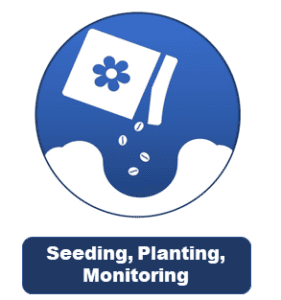Gucker, C.L.; Shaw, N.L.; Barga, S. 2023. A field guide companion to western forbs: Biology, ecology, and use in restoration. Boise, ID: U.S. Department of the Interior, Bureau of Land Management; U.S. Department of Agriculture, Forest Service, Rocky Mountain Research Station. 91 p.
Baughman, O.; Kulpa, S.; Sheley, R. 2022. Four paths toward realizing the full potential of using native plants during ecosystem restoration in the Intermountain West. Rangelands. 44(3): 218-226.
The Climate-Smart Restoration Tool is a GIS mapping program designed to help natural resource managers match seedlots with planting sites based on climatic information.
The Western Forbs: Biology, Ecology, and Use in Restoration project is designed to aid seed collectors, seed growers, nurserymen, landowners, restoration practitioners, and land managers as they increase the supply and use of native forbs.
Implementation of the SEEDS experimental restoration framework can move management options toward strategic treatments that increase project success, reduce the need for repeated treatments, and reduce costs. We will restore functional and resilient Great Basin ecosystems through, 1) experiments using local management and researcher knowledge, 2) monitoring a suite of integrated ecosystem processes, 3) determining…
Cooke, B.; Richardson, B.; Kilkenny, F.; St. Clair, B.; Finch, D.; Prendeville, H. 2019. Getting climate-smart with seeds: How a new software tool helps prepare landscapes for expected future conditions. Science You Can Use Bulletin, Issue 35. Fort Collins, CO: U.S. Department of Agriculture, Forest Service, Rocky Mountain Research Station. 11 p.
Richardson, B.A.; Kilkenny, F.F.; St. Clair, J.B. 2022. Web-based tools for sourcing seed adapted to future climates. Science Spotlight. U.S. Department of Agriculture, U.S. Forest Service, Rocky Mountain Research Station.
Miller, R.F.; Tausch, R.J.; McArthur, E.D.; Johnson, D.D.; Sanderson, S.C. 2008. Age structure and expansion of pinyon-juniper woodlands: A regional perspective in the Intermountain West. Research Paper. RMRS-RP-69. Fort Collins, CO: USDA Forest Service, Rocky Mountain Research Station. 15 p.
Jones, T.A.; Monaco, T.A. 2007. A restoration practitioner’s guide to the restoration gene pool concept. Ecological Restoration. 25: 12-19.
Friggens, M.M.; Pinto, J.R.; Dumroese, R.K.; Shaw, N.L. 2012. Decision support: Vulnerability, conservation, and restoration (Chapter 8). In: Finch, D.M., ed. Climate change in grasslands, shrublands, and deserts of the interior American West: a review and needs assessment. General Technical Report RMRS-GTR-285. Fort Collins, CO: U.S. Department of Agriculture, Forest Service, Rocky Mountain Research Station:…


